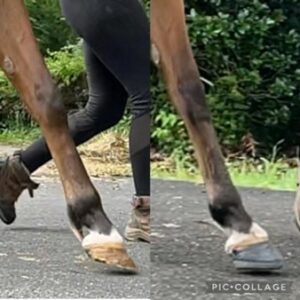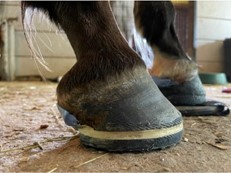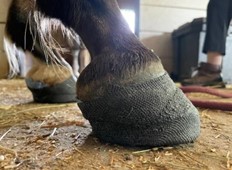Written By Casey Sexton of North Georgia Hoof Care
What are “heel-first landings,” and why are they important?
Heel-first landings refer to how hooves hit the ground in locomotion. Hooves can also land flat and toe-first. Within these parameters, we can also assess if a hoof is landing imbalanced, laterally or medially, instead of both sides hitting the ground simultaneously.
The significance of seeking a heel-first landing is based on several bodies of research that have found heel-first landings to be the healthiest overall for the hoof and its internal structures. Dr. Robert Bowker, DVM, Ph.D., is on the cutting edge of this research. He explains that when a hoof lands heel-first, the heel region, which comprises the frog, flexible lateral cartilages, and dense digital cushion, is the first to take the load. As the hoof continues to hit the ground, it expands, allowing blood to circulate within the capsule through the process of each footfall. The heel tissues then contract when the hoof is in flight again. This process of continued circulation with each step helps provide fresh blood flow throughout the entire distal limb. This action is nourishing to the hoof and internal anatomy, aiding in healthy hoof keratin production.
In contrast, when a horse lands toe-first, the hard hoof wall is the first to take the landing force. When this is chronic, it can lead to a host of unwanted issues, such as cracks, thinner and less concave soles, contraction of the heels due to lack of stimulation, and strain on tendons and ligaments, to name just a few problems.
Armed with this information, I like to assess my client’s horses to determine how they land using slow-motion video. This way, we can easily determine how the hooves are hitting the ground.
My horse is toe first! What can I do to help?
My favorite shoe to achieve heel-first landings (and many of the horses in my care) are EponaShoes. They are composite shoes made of three types of plastic with a metal nailing plate. These plastics have been studied and are designed to stabilize the hoof yet are malleable enough to expand and contract with the horse’s natural hoof capsule movement. There is also a blue “pad’ within the center of the shoe which reminds me of the density of the digital cushion. I believe the different densities of plastic, which are the perfect balance of rigidity and flexibility, combined with the comfortable pad insert, are the golden ticket for giving the horse comfortable caudal (back of the hoof) support. I often include Dental Impression Material (DIM) between the shoe and the sole for extra support and encourage more circulation.
Another bonus that these shoes provide is the ability to alter the mediolateral balance and the Hoof Pastern Axis (HPA) by simply adding more glue to the area that more lift is desired.
EponaShoes in Action

These are stills from slow-motion videos- pardon the pixelation.
I find it interesting to note the straightness in the knee (carpus) on the heel- first landing versus the slight bend on the to- first image.
This client had traditionally kept this horse peripherally shod in steel. As her 5-year-old trail riding horse, she was concerned when she noticed he was always landing toe-first. We opted to put him in this package as shown below:


The top image shows a glued on EponaShoe with DIM. The bottom picture shows casting material over the shoe and hoof, used as a secondary attachment method. You can use either casting or nails.
Now let’s look at another case, using a different EponaShoe application.

This is the same limb; the horse was going in different directions for the video.
This horse has a navicular diagnosis. He had been traditionally shod for years but was, unfortunately, becoming increasingly lame. I used a simpler package on this horse. This is a straight-nailed EponaShoe with a light layer of DIM. No glue or casting was used in this application. The horse retained the shoes for the entire cycle. I will add, however, that I now prefer to add a peripheral layer of glue to nail on applications. Due to these shoes’ wonderful flexibility, they can lead to clenches getting a bit loose by the end of the cycle. The peripheral layer of glue helps the shoe and hoof act more as a combined unit, reducing the “wiggle” on the nails. This was a happy day for the owners, myself, and especially the horse. Again, note the carpus bent on the left and straight on the right.
The Takeaway
Heel-first landings are the ideal way for a horse’s hooves to hit the ground. Chronic toe-first landings can lead to unwanted distal limb problems.
Take a slow-motion video of your horse’s footfalls. If they are landing toe-first, I hope you feel encouraged and informed about moving forward. Oftentimes, my clients find that chronic hoof problems their horse was dealing with are “magically” resolved simply by focusing on heel-first landings. So head on out to your barn aisle today, set up your camera, and get started!
 Meet the Author
Meet the Author
Casey Sexton lives in Atlanta, Georgia, and is the owner of North Georgia Hoof Care. She has had the privilege of learning this trade from her mother, who was the first woman to become a CJF in the state of Georgia! Casey also apprenticed with Pete Ramey for 2 years. She has been running her full-time hoof care business since 2018 and is thankful for each day she gets to wake up and help horses.